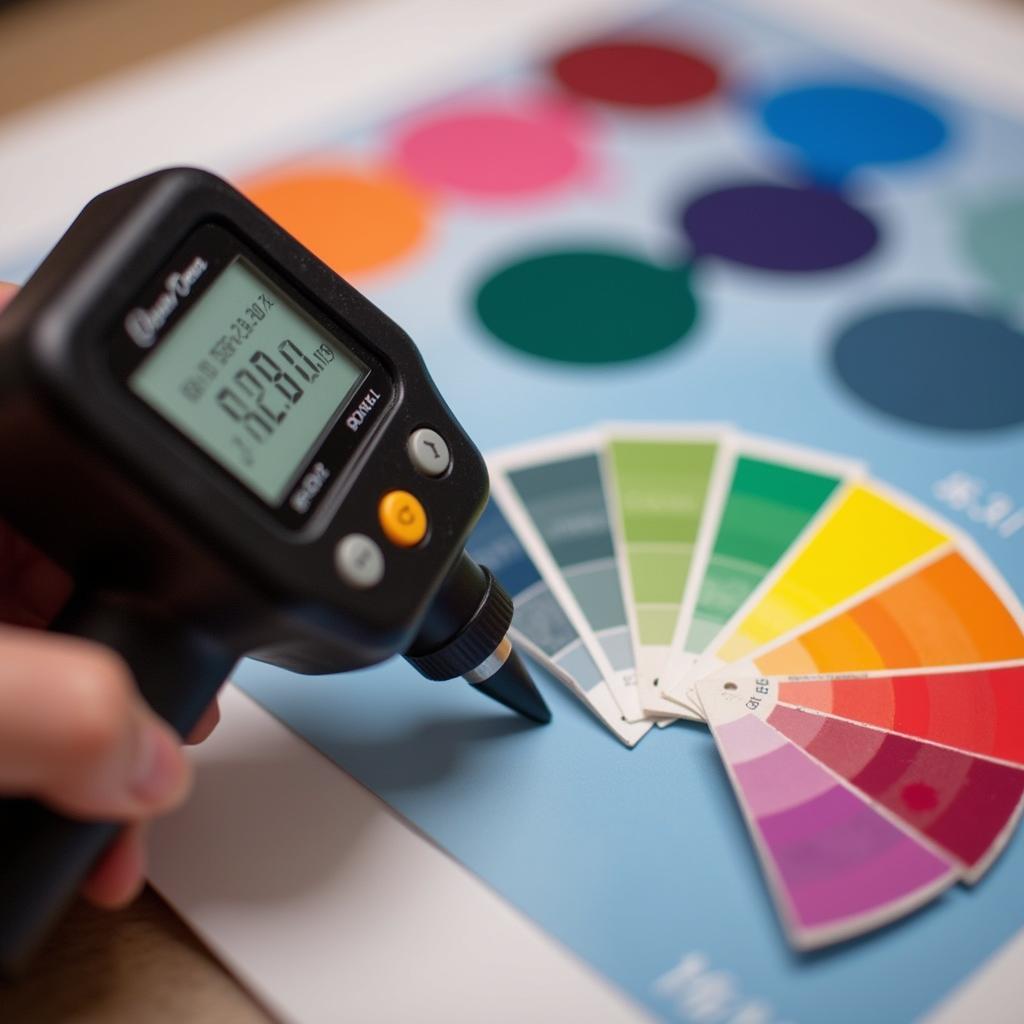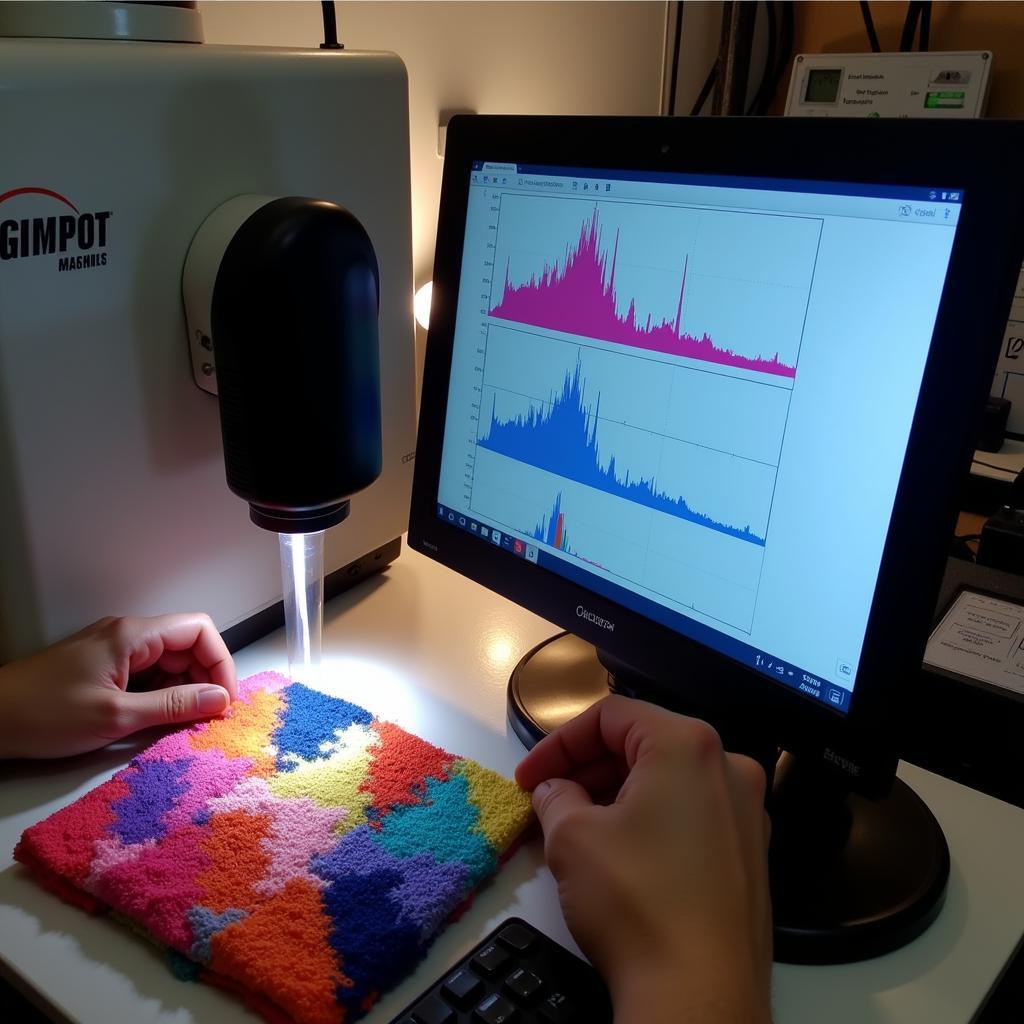Color is everywhere, influencing our moods, perceptions, and even purchasing decisions. But how do you measure something as seemingly subjective as color? Understanding color measurement is crucial in various fields, from paint manufacturing and graphic design to textiles and even food production. Accurate color measurement ensures consistency, quality control, and effective communication about color.
The Science Behind Color Measurement
Measuring color isn’t just about eyeballing it. It’s a precise science involving specialized instruments and standardized systems. While our eyes perceive color based on the light reflected from an object, color measurement devices quantify this reflection in a much more objective way. This allows for consistent and repeatable results, unlike relying on human perception which can vary significantly. There are a number of different methods employed to measure color, each serving specific purposes.
Similar to how you would test a small area before applying a full hair color, how to do a hair color patch test, color measurement allows for controlled and predictable outcomes in various industries.
Colorimetry: Quantifying Color with Numbers
Colorimetry is the most common method for measuring color. It utilizes a spectrophotometer, a device that measures the amount of light reflected or transmitted by an object at different wavelengths. This data is then used to calculate the object’s color coordinates within a specific color space, like CIE XYZ or CIE Lab*. These color spaces provide a numerical representation of color, allowing for objective comparisons and precise communication.
 Colorimeter Measuring Paint Sample
Colorimeter Measuring Paint Sample
Spectrophotometry: Analyzing the Full Spectrum
Spectrophotometry takes color measurement a step further by analyzing the entire spectrum of light reflected or transmitted by an object. This detailed analysis provides valuable insights into the object’s color composition and can be used to identify subtle color differences that might be missed by simpler colorimeters. This technique is especially important in industries where color accuracy is paramount, such as in the production of high-quality paints and textiles.
Color Matching Systems: Ensuring Consistency
Color matching systems, like Pantone or RAL, offer standardized color libraries that facilitate consistent color communication across different industries and platforms. These systems assign unique codes to specific colors, ensuring that everyone involved in a project, from designers to manufacturers, is referring to the same exact shade.
Just as preventing color bleeding in laundry requires specific techniques, how to prevent color bleeding in laundry, maintaining color consistency in various products requires careful measurement and standardization.
What Factors Affect Color Measurement?
Various factors can influence color measurement and should be considered for accurate results. These include the type of light source used, the angle of observation, the surface texture of the object being measured, and the calibration of the measuring instrument. Controlling these variables is essential for obtaining consistent and reliable color data.
Light Source: Illuminating the Truth
The light source used during color measurement significantly impacts the perceived color. Different light sources emit different wavelengths of light, leading to variations in how colors appear. Standardized light sources, like D65 (representing average daylight), are used in colorimetry to ensure consistent results across different environments.
Observer Angle: Perspective Matters
The angle at which color is observed also affects its perception. This is especially true for materials with complex surface textures or finishes. Color measurement instruments often incorporate standardized viewing angles to minimize this effect.
 Spectrophotometer Analyzing Fabric Color
Spectrophotometer Analyzing Fabric Color
Applications of Color Measurement
The ability to accurately measure color has far-reaching applications across numerous industries.
Graphic Design and Printing: Ensuring Visual Harmony
In graphic design and printing, accurate color measurement is essential for ensuring that the colors on screen match the colors in the final printed product. This avoids costly reprints and ensures brand consistency.
Textile Industry: Matching Shades and Dyes
In the textile industry, color measurement is used to match dyes and ensure consistency across different batches of fabric. This is particularly important in large-scale production where even slight color variations can be noticeable.
This has parallels with the observation of whether birds poop on certain color cars, as explored in [do birds poop on certain color cars](https://colorbox.com.vn/do birds-poop-on-certain-color-cars/), highlighting the impact of color in unexpected contexts.
Paint Manufacturing: Precise Color Formulation
Paint manufacturers rely heavily on color measurement to formulate precise color mixes and ensure consistency across different batches of paint. This allows customers to achieve the desired color every time they purchase a particular shade.
Conclusion
Understanding how to measure color is crucial for achieving accuracy, consistency, and effective communication in various fields. From the precise science of colorimetry to the standardized systems used for color matching, the methods discussed in this article provide the tools necessary for mastering the world of color. Accurate color measurement empowers professionals and individuals alike to create and maintain the desired visual experience in their respective endeavors. When dealing with complex projects, accurate color measurement is as essential as understanding the implications of a climate miracle in the Colorado River, as discussed in a climate miracle in the colorado river. For any questions regarding color or if you need assistance with color solutions, contact us at Phone Number: 0373298888, Email: [email protected] or visit our address: 86 Cau Giay, Hanoi. We have a 24/7 customer service team.
FAQ
- What is the most common method for measuring color? Colorimetry, using a spectrophotometer.
- What are color spaces used for? Providing a numerical representation of color.
- Why is the light source important in color measurement? Different light sources affect how colors appear.
- How does spectrophotometry differ from colorimetry? It analyzes the entire spectrum of reflected or transmitted light.
- Why is color measurement important in the textile industry? To ensure color consistency in fabrics and dyes.
- What are some factors that can affect color measurement? Light source, observer angle, surface texture, instrument calibration.
- Where can I get help with color measurement for my business? Contact us at the provided contact information.
Considering the impact of color on various aspects of design, you might also be interested in learning about what wall color goes with gray curtains to create a harmonious living space.
Need help with color matching or finding the perfect shade for your project? Contact Color Box Hanoi today! Phone Number: 0373298888, Email: [email protected] or visit us at 86 Cau Giay, Hanoi. We offer expert advice and a wide range of color solutions to meet your needs. Our 24/7 customer service team is ready to assist you.
